On Saturday, September 19, 7:00 p.m. at VCC Theater, there will be a free screening of the movie, Heart of the Wilderness. The movie was filmed in May of 2014 on Garden Lake. In 2015, the film won the Duluth Superior Film Festival Maximus Lepus Award presented to the best film of the festival.
White Iron Chain Of Lakes Association
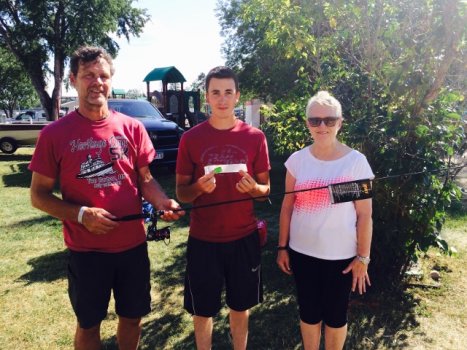 Paul Sires on behalf of Briana Nihart accepting the winning prize in the rusty crayfish count. Briana was one of three who guessed within one of the 116 crayfish in the two quart bottle. The rod and reel was donated by WICOLA members, Bob and Dolores Delaney.
Paul Sires on behalf of Briana Nihart accepting the winning prize in the rusty crayfish count. Briana was one of three who guessed within one of the 116 crayfish in the two quart bottle. The rod and reel was donated by WICOLA members, Bob and Dolores Delaney.
 Volunteers from WICOLA, Partner Organizations (Sea Grant, 1854 Treaty Authority, MPCA, Lake County, Lake SWCD, North St. Louis SWCD, Burntside Lake Association), and VCC Interns talked with approximately 800 visitors to the Blueberry Festival. Visitors to the booth welcomed the information provided about the spread and prevention of aquatic invasive species, and water monitoring in WICOL and surrounding lakes throughout the watershed. Thanks to all our volunteers and all those who continue to work to keep our waters clean!
Volunteers from WICOLA, Partner Organizations (Sea Grant, 1854 Treaty Authority, MPCA, Lake County, Lake SWCD, North St. Louis SWCD, Burntside Lake Association), and VCC Interns talked with approximately 800 visitors to the Blueberry Festival. Visitors to the booth welcomed the information provided about the spread and prevention of aquatic invasive species, and water monitoring in WICOL and surrounding lakes throughout the watershed. Thanks to all our volunteers and all those who continue to work to keep our waters clean!
Minnesota DNR, 7-20-2015
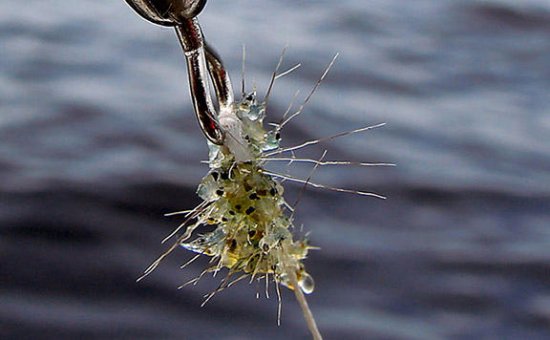 Anglers reported suspected spiny waterfleas to Department of Natural Resources staff and supplied a specimen to the DNR fisheries office in Tower, where it was positively identified. DNR aquatic biologists surveyed portions of the lake with plankton nets and weighted lines to confirm the presence of spiny waterflea in the lake. Live specimens were located near J B and Ely islands in the east basin.
Anglers reported suspected spiny waterfleas to Department of Natural Resources staff and supplied a specimen to the DNR fisheries office in Tower, where it was positively identified. DNR aquatic biologists surveyed portions of the lake with plankton nets and weighted lines to confirm the presence of spiny waterflea in the lake. Live specimens were located near J B and Ely islands in the east basin.
Lake Vermilion and the Vermilion River will be designated as infested waters, and signs will be posted at public water access points to alert boaters and other recreationists. Crane Lake, a downstream water, is already designated for spiny waterflea.
“DNR staff are coordinating with the Bois Forte Band of Chippewa and U.S. Forest Service to alert boaters and other recreationists of the risk of spread,” said Rich Rezanka, DNR aquatic biologist.
Spiny waterflea is a small crustacean that disrupts the food web and competes with small fish as it forages on animal plankton such as daphnia. Because of its long tail spike, the spiny waterflea is not eaten by small fish.
The species reproduces by a process called parthenogenesis. Most of the year, the species population is entirely female, which allows for rapid population growth. Microscopic spiny waterflea eggs are hardy and capable of overwintering in lakes, and their small size makes them an easy candidate for overland transfer in water or mud.
When populations are high, anglers can experience frustration with masses of spiny waterfleas clogging fishing and downrigging lines, and other water equipment.
Recreationists on these lakes should look for infested waters signs at public accesses. The signs remind people using the lakes to be aware of the finding and take additional precautions to prevent the spread to other lakes. Bait harvest for any purpose is prohibited in lakes infested with spiny waterflea.
Anglers, boaters and other recreationists are reminded to clean all aquatic plants, zebra mussels, and other prohibited invasive species from watercraft and trailers, drain water from all water equipment and drain bilges and livewells by removing the drain plug before leaving the boat landing, and dispose of unwanted bait in the trash.
More information about spiny waterfleas, how to inspect boats and other water-related equipment, and a current list of designated infested waters is available on the DNR website; http://www.dnr.state.mn.us/invasives/aquatic/index.html
Attending the Blueberry Festival which runs from Friday, July 24th, to Sunday, July 26th? Then come by the WICOLA Booth (#175) and take this opportunity to visit, check out the AIS (Aquatic Invasive Species) materials, and enter the “guess the number of Rusty Crayfish” contest to win a special prize. WICOLA members and representatives from partner organizations will be at the booth to answer questions, to provide updates on AIS in Northern MN and to share AIS prevention information.
See you there.
WICOLA members may be interested in the following events on July 21 and July 22 that address AIS and other potential impacts to water quality. The Speaker for these events, Dr. Lee Frelich, PhD., Director of the University of Minnesota Center for Forest Ecology, is being sponsored by “Save the Boundary Waters”.
Tuesday, July 21, 2015
Ely Tuesday Group: Climate Change and Invasive Species Impacts – The Boundary Waters Ecosystem
Location and Time: Grand Ely Lodge, 12:00 p.m.
Summary: Dr. Lee Frelich will present “Ecological Impacts of Climate Change and Invasive
Species in the Boundary Waters.”
Tuesday, July 21, 2015
Vermilion Community College: Sulfide-Ore Mining Impacts – The Boundary Waters Ecosystem
Location and Time: VCC Fine Arts Theater, 6:30 p.m.
Summary: Becky Rom and Dr. Lee Frelich will present “How Sulfide-Ore Mining Threatens the
Boundary Waters and Voyageurs National Park: The Science”. Dr. Lee Frelich is the Director of
the University of Minnesota Center for Forest Ecology. He has found research that has shown
that proposed sulfide-ore mining would negatively affect both the direct footprint of mine
facilities and a larger secondary footprint that extends into the Boundary Waters Canoe Area
Wilderness. Dr. Frelich will also discuss impacts to the waters and wildlife.
Wednesday, July 22, 2015
Forest Hike with Dr. Lee Frelich
Location and Time: Dry Lake Trail, 9:30 a.m. – Meet at the Bass Lake parking lot by 9:20 a.m.
Summary: Learn from an expert about the evolving forest due to climate change and invasive
Species. A 2-3 hour morning walk on Dry Lake Trail led by Dr. Lee Frelich.
As a follow up to the recent article in the Summer Newsletter “White Iron Chain of Lakes and Its Water Levels”, Minnesota Power has now published on their website the Garden Lake and Birch Lake Operating Band Charts. These charts graph the “Target” lake elevations as well as the “Upper” and “Lower” Operating Bands (Located at the lower left of the webpage). These charts can be used along with the “Current Elevations Data” to help you determine where water levels are forecasted to be and how that might affect your shoreline and dock positioning.
To stay informed about the current water level elevations, flow, and conditions, please check the Minnesota Power webpage at;
http://web15.mnpower.com/web/public/Hydro/ShorelandTraditions/Levels.html
The Lake County Board of Commissioners will convene at the Fall Lake Town Hall on Tuesday, June 16 at 6:00 p.m. The purpose of this Lake County Board Meeting is to meet face to face with local citizens. This meeting is an opportunity for citizens to ask questions and express concerns specific to Lake County directly to the County Commissioners.
Neither rain, sleet, snow or below freezing temps the night before could stop the WICOLA water monitoring team from going out at 8:15 am today to complete the first of six monthly water monitoring / testing excursions on our chain. They were wrapped up ready for the cold temps...but fortunately the sun came out once the team hit the water!!
To stay informed about the current water level elevations, flow, and conditions, please check the Minnesota Power webpage at;
http://web15.mnpower.com/web/public/Hydro/ShorelandTraditions/Levels.html
And the USGS stream flow report covering the inflow to Birch Lake Reservoir at;
http://waterdata.usgs.gov/mn/nwis/uv/?site_no=05125000&PARAmeter_cd=00065,00060
White Iron Lake, Farm Lake, Garden Lake
Some stubborn lingering ice remains is some bays and isolated areas. Most of the lake is ice free so the unofficial call is that the ice is out.
Other Area Lake Reports
Robinson, Clear Lake & Armstrong are all out.
Wildfires often begin unnoticed. These fires are usually triggered by lightning or accidents, igniting brush, trees, and homes. They spread quickly, especially with the current extreme conditions we are facing in Lake and St. Louis Counties due to a combination of high winds, warm temperatures, low humidity and little significant rain in the forecast until Sunday (4/19). Reduce your risk by preparing now - before a wildfire strikes.
There are critical steps to follow “Before”, “During”, and “After” to protect your family, home, and property. To learn more and to become better prepared, go to; www.ready.gov/wildfires and click on the Before, During, and After Tabs.
White Iron Lake
Although the area between the ring rock points was iced in part 24 hours ago, as of noon today (4/15) it is open all the way across and the high winds continue to erode the ice quickly. There is a large open area off the boat ramp on South White Iron road and it extends up to the narrows at the ring rock points. Ice on both the East and West ends continues to deteriorate quickly.
View from White Iron Lake near the Ring Rock Points
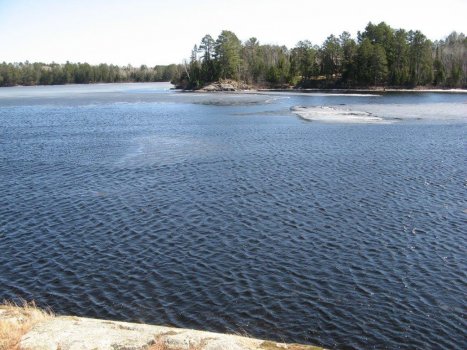
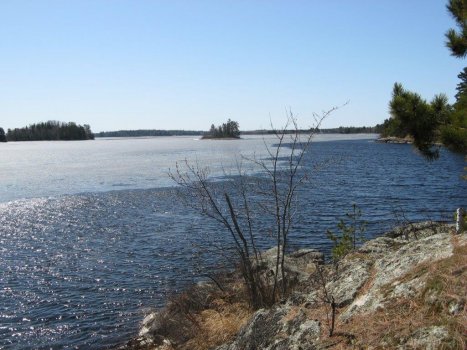
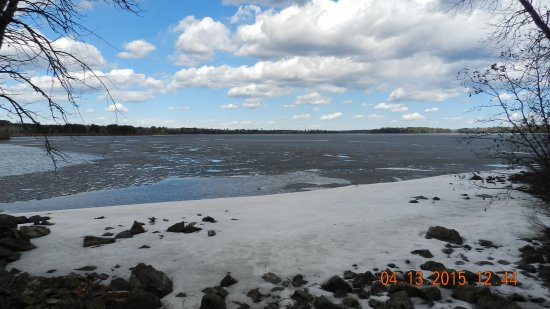
White Iron Lake
Some shoreline areas have a small amount of open water depending on location and wind direction. Several bays that are shallow are also becoming ice free. Today the ice between the ring rocks is about 25% open and the ice looks only a couple inches deep…Yesterday it looked close to 6”. There are now major cracks in the ice and several of the pieces are shifting and grinding together. The main lake ice on both the East and West ends of the lake is very black and deteriorating quickly, especially with the warm weather and winds this past weekend...lake should be open in a few days.
Farm Lake
The ice along the shorelines is opening enough for the buffleheads to swim and dive and in the middle of the lake there is a large opening where seagulls and ducks are swimming. The ice is turning black and is rotten in a lot of places which means if these temperatures, wind and sun continue with night temps hovering above freezing for the rest of the week, ice will be gone.
Garden Lake
There is still no open water except small areas around the shoreline. Across the lake, where the Kawishiwi River flows through Garden, there is still ice. With the ice turning black, high winds and warmer temps, expect to see some open water soon. At the Fernberg Bridge, there is open water about 50 yards upstream where Garden Lake flows toward the dam.
Birch Lake
The ice is turning black, won’t be long until ice out.
Join us for a training session at Vermillion Community College at 3:30 PM on Wednesday April 22nd (Earth Day). We will be reviewing the procedures for conducting Citizen Stream Monitoring, Citizen Lake Monitoring as well as the sampling procedures for water sampling to monitor for nutrients. We will also be reviewing sampling protocols, chain of custody forms and sonde calibration, maintenance, and proper use.
This training is open to any WICOLA member interested in helping with water monitoring from May-September as well as to any member who just wants to learn more about Water Monitoring.
For further information or questions, please contact Nancy Powers
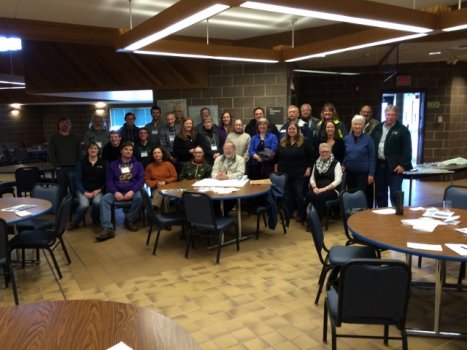 On March 12, WICOLA Members, Nancy Powers and Teresa Sagen, joined a group of about 30 people at Vermilion Community College to address invasive species and sustainable landscapes in Northern Minnesota. The workshop was organized by Ely Field Naturalists, Superior National Forest, and the 1854 Treaty Authority. The workshop was led by representatives from The Stewardship Network, located in Lansing, MI, and focused on the strength of working together as a Collaborative Conservation Community for a more collective impact. Individuals and organizations represented at the workshop will continue to explore the potential for forming a CCC. The Stewardship Network is a national award-winning conservation group with the purpose of connecting, equipping and mobilizing people and organizations to care for land and water. For more information and resources, check out The Stewardship Network website at www.stewardshipnetwork.net
On March 12, WICOLA Members, Nancy Powers and Teresa Sagen, joined a group of about 30 people at Vermilion Community College to address invasive species and sustainable landscapes in Northern Minnesota. The workshop was organized by Ely Field Naturalists, Superior National Forest, and the 1854 Treaty Authority. The workshop was led by representatives from The Stewardship Network, located in Lansing, MI, and focused on the strength of working together as a Collaborative Conservation Community for a more collective impact. Individuals and organizations represented at the workshop will continue to explore the potential for forming a CCC. The Stewardship Network is a national award-winning conservation group with the purpose of connecting, equipping and mobilizing people and organizations to care for land and water. For more information and resources, check out The Stewardship Network website at www.stewardshipnetwork.net
Northshore mining has proposed an expansion of its Peter Mitchell Mine in Babbitt that has the potential for future impacts on the Kawishiwi Watershed, including WICOL. Environmental organizations have requested a full (state) Environmental Impact Statement from the lead agency, MN DNR. Although DNR had promised a response by January 27, no statement has been issued. Similar requests have been made to the Minnesota Pollution Control Agency and the federal Environmental Protection Agency which must issue permits for the mine expansion to proceed.
The Peter Mitchell Mine produces taconite ore. The primary issue concerns the approximately 15 foot overburden of sulfide ore rock that must be removed and stored to reach the taconite deposit. Sulfide bearing rock, when exposed to air and water, produces the toxic waste found in copper nickel mine operations. The current EAW for the project contains no agency requirements to protect the disposed rock from water and air, and to treat discharges should water seepage occur. Nor have agencies provided information on potential fractures in the bedrock of the storage site. The mine and waste storage sites currently drain into both the Rainy River Basin / Kawishiwi Watershed, and into the Lake Superior Basin.
Additional information can be obtained from:
Minnesota DNR website, www.dnr.state.mn.us – environmental review – projects – Northshore Mining
Mining Company, www.cliffsnaturalresources.com – Northshore Mining
An environmental organization, www.waterlegacy.org – Northshore Mine
Think of the last time you planned a visit to a lake. Why did you choose the lake you did? Did you consider the quality of the water? The answers to these questions are critical to understanding how lake users make decisions about their recreation choices and the value society places on water resources.
New research published in Frontiers in Ecology and the Environment presents a novel approach to calculating the value of clean water. Analyzing photos posted to the online photo-sharing site Flickr, researchers at the Natural Capital Project and Iowa State University found Minnesota and Iowa lakes with greater water quality receive more visits than dirtier lakes, and that users are willing to travel farther to visit those clean, clear lakes.
The traditional approach to gathering Lake Visitation data would be through expensive and time-consuming surveys, asking people where they recreate and why. In this study, the researchers used online photographs taken of lakes that were uploaded to Flickr and could easily be analyzed with minimal expense. The researchers used this information, along with spatial analysis techniques and models, to estimate the values users place on lakes.
“The photos tell us a story about what lakes people prefer, where they live, and how far they travel to visit different lakes” said Bonnie Keeler, co-author and lead scientist with the Natural Capital Project at the University of Minnesota’s Institute on the Environment.
As the authors note, there are many lakes and rivers that are impaired and efforts to restore or improve water quality can be expensive. This study offers one approach to capturing the value of water quality improvements — information that can inform cost benefit assessments and better targeting of restoration investments. The study is also valuable because it underscores the potential for social-media data to inform social–ecological research.
The Natural Capital Project is a partnership combining research innovation at the University of Minnesota’s Institute on the Environment and Stanford University with the global reach of conservation science and policy at The Nature Conservancy and the World Wildlife Fund.
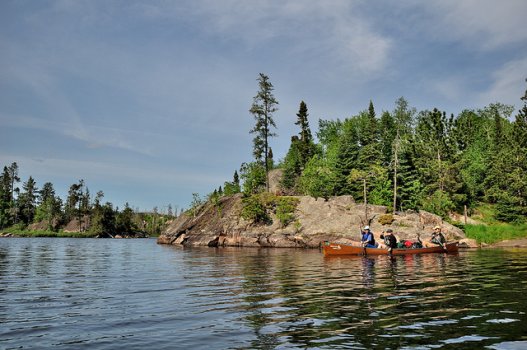
The International Joint Commission (IJC) strongly recommends that the governments of Canada and the United States undertake all 32 projects identified in the final Plan of Study it has delivered to them to address the complex water quality challenges facing the Lake of the Woods Basin.
In the summer of 2012, both governments agreed to the development of a water quality plan of study for the Basin, which was recommended in the Commission’s January 2012 “Report to the Governments of the United States and Canada on Bi-national Water Management of the Lake of the Woods and Rainy River Watershed.”
“The Plan was prepared by a binational Study Team at the direction of the IJC and is based on extensive engagement with public agencies, scientific and technical experts, community groups, First Nations, Métis and Tribes and the general public,” added U.S. Chair, Lana Pollack. “It also follows two periods of public review and feedback, and builds upon considerable cooperative work and planning that has been undertaken in the basin in recent years.”
The Plan of Study identifies five themes of concern, and strongly recommends funding for 32 projects and activities to support a balanced approach to water quality management, in response to concerns by governments, researchers, local residents and indigenous peoples about the Basin’s ecosystem health.
1. Monitoring – 1 project to provide long-term, consistent data to track trends in nutrients, contaminants and aquatic invasive species. The Commission identified this project as a priority.
2. Nutrient enrichment and harmful algal blooms – 11 projects to improve their management, reduce their severity and frequency, as well as the risks associated with the algal toxins they can release
3. Aquatic invasive species – 7 projects to strengthen ongoing prevention measures and pursue control efforts to curb the negative effects of the many invasive species now residing in the Basin
4. Surface and groundwater contamination – 7 projects to better understand contamination sources, assess the vulnerability of water resources and establish protective measures
5. Capacity building – 6 projects to engage all Basin interests on water quality management and promote greater cooperation among agencies working in it
The Plan also recommends four projects for immediate action to address significant, pressing risks to the Basin’s ecosystem health:
· International Platform for Implementation. This project is crucial to the successful implementation of the Plan of Study and future binational management opportunities.
· Rapid Evaluation and Implementation of Options to Manage Recent Zebra Mussel Infestation in Headwaters Areas in Minnesota. Zebra mussels pose a significant, immediate risk to the ecosystem health of the Basin.
· Long-term Funding of Wheeler’s Point Gage and Designation as a Gage of Binational Significance. This is a critical component for determining ecosystem health in the Basin.
· Implementation of Proven Best Management Practices (BMPs) and Removal of Solids from Effluent. Where BMPs have been identified as effective at reducing nutrient loads from agricultural lands, they should be implemented immediately. Effluent from sewage and wastewater treatment facilities is an important source of nutrients that can impact lakes and rivers. An immediate action to reduce nutrients would be to enhance the capacity of treatment facilities to reduce solids.
For more information, please contact;
Dominique Guerin-Garnett Frank Bevacqua
Ottawa, ON Washington, D.C.
613-947-1420 202-736-9024
Links:
Report on Bi-National Water Management of the Lake of the Woods – Rainy River Watershed
International Lake of the Woods Basin Water Quality Plan of Study, January 2015
DNR NEWS – FOR IMMEDIATE RELEASE Jan. 28, 2015
The Minnesota Department of Natural Resources will postpone the new aquatic invasive species training and trailer decal program that was due to launch at the end of the month while legislators consider changes to the program.
Under a law passed by the state Legislature in 2012, anyone trailering a boat or water-related equipment such as docks and lifts in Minnesota is required to take aquatic invasive species training and display a decal on their trailer. The effective date is July 1, 2015.
“With the legislative interest in this educational program and ongoing discussions about possible changes, we are postponing the launch until we see if the Legislature acts this session to modify the program,” said Bob Meier, DNR assistant commissioner.
The DNR supports the education that would be provided under this law, but recognizes there are some concerns with the way the law is currently written. For example, people transporting boats on trailers through Minnesota to another destination are required to take the course and display a decal even if they don’t put their boat in Minnesota waters.
Since the training and decal are currently not required until July 1, the DNR wants to remind people that there will be time to see what happens legislatively and still take the course and receive decals. The agency will post any updates on trailers at www.trailers.mndnr.gov and alert the media if there are any program changes.